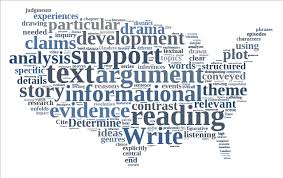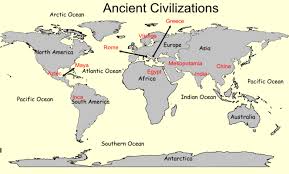World History and Geography: Ancient CivilizationsCOURSE SYLLABUS:
6th Grade The Ancient World Course Description Students in grade six expand their understanding of history by studying the people and events that ushered in the dawn of the major Western and non-Western ancient civilizations.. After reviewing the ancient world and the ways in which archaeologists and historians uncover the past, students study the history and geography of great ancient civilizations. They examine the growing economic interaction among civilizations as well as the exchange of ideas, beliefs, and technologies. They learn about the resulting growth of the Agricultural Revolution and examine of the natural rights of human beings and the divine right of kings, experimentalism in science, and the dogma of belief. Finally, students assess the political forces let loose by the ancient Greek and Roman civilizations, particularly the achievements, the rise of democratic ideas, and they learn about the continuing influence of these ideas in the world today. Instructional Approaches In this class, you will be using, participating, and engaging in a variety of methods to learn about World History during the ancient world. Some of the methods are:
Student Notebooks We will be using two different notebooks in class. First is the Interactive Student Notebook. Many of our reading assignments and in-class activities will utilize our Interactive Notebooks. These will be collected randomly for review and grading and will account for 1/3 of your Notebook grade. Individual pages will sometimes be attached to your History Notebooks. Secondly, you will keep a History Notebook as your portfolio. In your portfolio, you will keep your warm-ups and many other written assignments. Because you do not know when I will collect your portfolios, it is your responsibility to keep up with your assignments and be prepared to include many of the best examples of your work in your portfolios. Your History Notebook will account for the other 2/3 of your Notebook grade. Together these will account for @20% of your grade. Course Instructions and Requirements: Read the text History Alive! The Medieval World and Beyond
Texts: History Alive! The Ancient World
Grades: Assignment Percent of Grade Total Score
Total 100% Grading Scale: A = 90-100%
California State Content Standards for 6th Grade History 6th grade language artsCOURSE SYLLABUS Instructional Component 1: Narrative Representative Standards (Standards sets included) R 3.2 Analyze the effect of the qualities of the character (e.g., courage or cowardice, ambition or laziness) on the plot and the resolution of the conflict. R 3.6 Identify and analyze features of themes conveyed through characters, actions, and images. W 2.1 Write narratives:
Instructional Component 1 identifies and groups key skills and concepts in the area of narration. Students will read a rich selection of texts to examine features of literary themes, analyze and examine how authors create characters to convey those themes, and examine how authors use character development to affect the plot of a story. They will examine setting, point of view, and literary devices through the lens of characterization and plot development. They will use what they have learned from examining the fictional and nonfictional narratives of others as they create their own narratives using the writing process to develop plot, characters, and settings. They will read and write narratives, listen to stories read aloud, and speak about what they have read, written, and heard. Instructional Component 2: Exposition Representative Standards (Standards sets included) R 2.4 Clarify an understanding of texts by creating outlines, logical notes, summaries, or reports. R 2.7 Make reasonable assertions about a text through accurate, supporting citations. W 2.2 Write expository compositions (e.g., description, explanation, comparison and contrast, problem and solution):
Instructional Component 2 identifies and groups key skills and concepts in the area of exposition in which students learn the primary purposes of expository text and how writers achieve their purpose by using details, facts, and content-specific information. Students will read a rich selection of texts to make reasonable assertions through accurate, supporting citations and by creating outlines, logical notes, summaries and reports. They will listen to texts read aloud, and speak about what they have read, written, and heard. Students will use what they have learned from examining the works of others as they write a variety of their own compositions. They are guided through the writing process by writing expository compositions of description, explanation, comparison and contrast, and problem and solution. They will listen to stories read aloud and speak about what they have read, written, and heard. Instructional Component 3: Response to Literature/ Text Representative Standards (Standards sets included) R 3.2 Analyze the effect of the qualities of the character (e.g., courage or cowardice, ambition or laziness) on the plot and the resolution of the conflict. R 3.8 Critique the credibility of characterization and the degree to which a plot is contrived or realistic (e.g., compare use of fact and fantasy in historical fiction). W 2.4 Write responses to literature:
Instructional Component 3 extends the strategies described in the fifth grade to more complex narrative and informational texts that allow students to access the full range of the English-Language Arts Standards around literary response and analysis. Students will learn to document character actions by reading and analyzing multiple examples under teacher-guided conditions to eventually produce independent written analyses. They will analyze the effect of the qualities of character in a text and critique the credibility of the characterization and the degree to which the plot is contrived. Students will advance their writing to extended responses to literature by engaging in discussions, using forms of writing that best suit the intended purpose, creating multiple-paragraph expository compositions around literature/text, and using a variety of effective and coherent organizational patterns, including comparison and contrast; organization by categories; and arrangement by spatial order, order of importance, or climactic order. Instructional Component 4: Argumentative Representative Standards R 2.6 Determine the adequacy and appropriateness of the evidence for an author's conclusions. R 2.8 Note instances of unsupported inferences, fallacious reasoning, argumentative, and propaganda in text. W 2.5 Write argumentative compositions:
Scope and Sequence (8 to 12 weeks) Instructional Component 4 identifies and groups key skills and concepts in the area of argumentative that include skills used to identify, evaluate, and analyze the credibility, accuracy and efficacy of an author’s argument. Students will read a rich selection of texts to determine the adequacy and appropriateness of the evidence for an author’s conclusions and note instances of unsupported inferences, fallacious reasoning, argumentative, and propaganda in a text. Students will use what they have learned from examining the works of others as they learn to construct successful arguments of their own and create their own argumentative compositions, both orally and in writing. Using research, students will write argumentative compositions that state a clear position on a proposition or proposal, support the position with organized and relevant evidence, and anticipate and address reader concerns and counterarguments. Representative Performance Outcomes and Skills In this course, students will know and be able to:
Representative Performance Outcomes and Skills In this course, students will know and be able to:
Focus Standards R 3.2 Identify events that advance the plot and determine how each event explains past or present action(s) or foreshadows future action(s). R 3.3 Analyze characterization as delineated through a character’s thoughts, words, speech patterns, and actions; the narrator’s description; and the thoughts, words, and actions of other characters. R 3.4 Identify and analyze recurring themes across works (e.g., the value of bravery, loyalty, and friendship; the effects of loneliness). W 2.1 Write fictional or autobiographical narratives:
|



